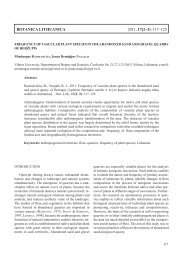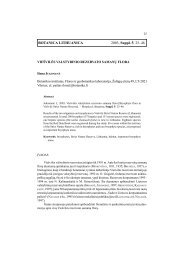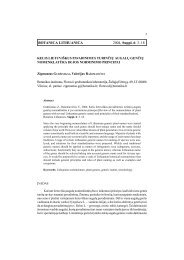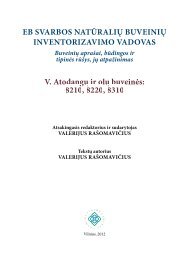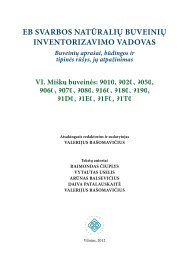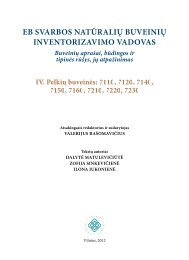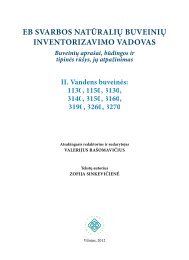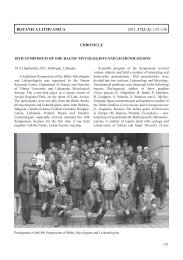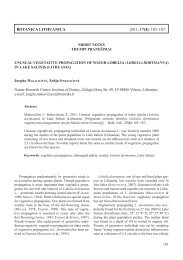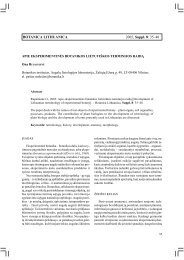FUNGI AND LICHENS IN THE BALTICS AND BEYOND XVIII ...
FUNGI AND LICHENS IN THE BALTICS AND BEYOND XVIII ...
FUNGI AND LICHENS IN THE BALTICS AND BEYOND XVIII ...
Create successful ePaper yourself
Turn your PDF publications into a flip-book with our unique Google optimized e-Paper software.
important because of the recently described changes in natural forest ecosystems caused not<br />
only by their economic exploitation but also by the global warming.<br />
<strong>THE</strong> LICHEN GENUS Ochrolechia <strong>IN</strong> EUROPE<br />
M. KUKWA<br />
Department of Plant Taxonomy and Nature Conservation, University of Gdańsk, Al.<br />
Legionów 9, PL-80-441 Gdańsk, Poland<br />
E-mail: dokmak@ug.edu.pl<br />
27 taxa of Ochrolechia have been confirmed from Europe, with one taxon tentatively<br />
referred to O. aff. mahluensis. One species has been described as new and one new<br />
combination proposed. Ochrolechia mahluensis has been proposed for O. androgyna A sensu<br />
Tønsberg (1992) with O. androgyna var. pergranulosa as its synonym. The new division of<br />
the genus into taxonomically informal groups and 18 new synonyms have been proposed. 44<br />
names have been lectotypified and two epitypified. Four names have been excluded from the<br />
genus, and the identity of 12 names has remained unclear. New data on the chemistry have<br />
been reported. Ochrolechia juvenalis, O. oregonensis, O. subathallina and O. subpallescens<br />
have been excluded from the European lichen biota.<br />
<strong>LICHENS</strong> AS <strong>IN</strong>DICATORS OF OLD-GROWTH <strong>AND</strong> PRIST<strong>IN</strong>E FORESTS <strong>IN</strong><br />
RUSSIAN FAR EAST<br />
E. S. KUZNETSOVA, D. E. HIMELBRANT,<br />
I. S. STEPANCHIKOVA<br />
Department of Botany, St. Petersburg State University, Universitetskaya Emb. 7/9, 199034 St.<br />
Petersburg, Russia<br />
Laboratory of Lichenology and Bryology, Komarov Botanical Institute of RAS, Prof. Popov<br />
Str. 2, 197376 St. Petersburg, Russia<br />
E-mails: igel_kuzn@mail.ru, d_brant@mail.ru, stepa_ir@mail.ru<br />
In contrast to Europe, the investigation of lichens as indicators of long ecological<br />
continuity of the forests has a quite short history in Russia (Red Data Book of Komi Republic,<br />
1998, 2009; Anderson et al., 2009). However the attempts to select indicators for the purpose<br />
of their further use to surveying of forests and evaluation of their quality were undertaken not<br />
only in European part of Russia, but in the Far East as well.<br />
During last ten years the lichen flora of main plant communities of Kamchatka<br />
Peninsula was investigated in the frame of the phytosociological expeditions of Komarov<br />
Botanical Institute RAS (e. g., Neshataeva et al., 2002–2009; Himelbrant, Stepanchikova,<br />
2011). The complexes of species indicating the long ecological continuity of stone-birch<br />
(Betula ermanii), spruce (Picea ajanensis) and flood-plain forests (dominated with Populus<br />
suaveolens and Chosenia arbutifolia) were detected. Some of the species were included in<br />
Red Data Book of Kamchatka Region (2007) as associated with rare and vulnerable<br />
communities. Abies gracilis stand remains on Kamchatka only as a very small grove (ca. 20<br />
ha) on the Eastern Coast. The lichen flora of this community is quite poor and doesn't include<br />
any indicator species.<br />
The first investigation aimed to select species associated with undisturbed old-growth<br />
and pristine forests in Primorye Region (Sikhote Alin’) were carried out in 2010. Fir-spruce



